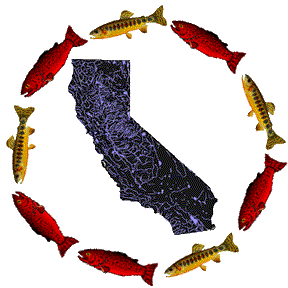CSPA
California Sportfishing Protection Alliance
“Conserving California’s Fisheries | | Home | | More News | | | "Ocean conditions may be the potential icebergs for salmon populations, but the ship is being steered by us humans. Salmon populations can be managed to avoid an irreversible crash, but continuing on our present course could result in loss of a valuable and iconic fishery." Peter B. Moyle | | | Your 501(c)(3) tax deductible cash donations are desperately needed if the fight for our fisheries is to continue. Read how you can donate! | | | | | | | | | | | | | | | | | | | | | |
|   More News More News

F&G Commission Closes Salmon Fishing On Central Valley Rivers By Dan Bacher
May 9, 2008. For the first time ever, recreational salmon fishing will be closed on the Sacramento River and its tributaries this year with the exception of a short season for late fall run run chinook. The Sacramento River salmon season has opened on July 16 every year, but will remain closed this season until November 1 when a limited stretch of river will be opened to the take of salmon. The California Fish and Game Commission voted unanimously today to adopt a zero bag limit in all 14 Central Valley rivers and streams except for a one-salmon bag limit in the Sacramento River from Red Bluff Diversion Dam to Knights Landing from November 1 to December 31. The Feather, American, Yuba and other popular salmon rivers will be closed to the take of spring run chinook salmon also. “The Department proposed and recommended this option, a hybrid of the originally proposed Options 2 and 3, because of concerns about impacts to spring chinook salmon,” said Steve Martarano, Department of Fish and Game (DFG) spokesman. “This option will provide maximum protection to Sacramento River fall chinook in the Central Valley while providing very limited access to late-fall chinook.” Anglers will be able to fish for rainbow trout, steelhead, shad, sturgeon, striped bass, catfish, black bass and other species on the Sacramento River and its tributaries, according to Neil Manji, branch chief of the inland fisheries division of the DFG. The closure of salmon fishing on Central Valley rivers will cause an estimated loss of over $20 million to the state's economy. This river closure follows the closure of all recreational and commercial fishing on the ocean in California and most of Oregon in April by the federal regulatory body, the Pacific Fishery Management Council (PFMC), and the state. The anticipated economic loss to California of the closure of the recreational ocean fishery will be around $167 million, while the economic loss of the commercial fishery will be approximately $63 million, according to DFG data. The Klamath and Trinity rivers will be open to salmon fishing this year with the quota for recreational anglers over 20,000 fish. "If there is any silver lining to the dark cloud of the salmon closure, it will be the fishery on the Klamath and Trinity," said Manji. The specific bag limits and other regulations for the Klamath system will be approved at the Fish and Game Commission on May 22-23. Expect to see lots of anglers on the Klamath and Trinity this year, since this system will be the only one where you will be able to take river salmon, other than the limited late fall fishery on the Sacramento. This decision to close the river and ocean waters to salmon fishing is caused by the unprecedented collapse of Sacramento River chinoook salmon, the result of years of federal and state government mismanagement. Although the state and federal government officials claim that “ocean conditions” are the likely culprit, a coalition of recreational and commercial fishermen, Indian Tribes, conservation groups and some prominent scientists contends the collapse was spurred by increased water exports, declining water quality and other freshwater habitat problems. Peter B. Moyle, Professor of Fish Biology at U.C. Davis, says blaming “ocean conditions” for salmon declines is like blaming the iceberg for sinking the Titanic. "Ocean conditions may be the potential icebergs for salmon populations, but the ship is being steered by us humans," observed Moyle. "Salmon populations can be managed to avoid an irreversible crash, but continuing on our present course could result in loss of a valuable and iconic fishery." |
|
|